|
.
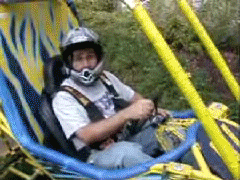 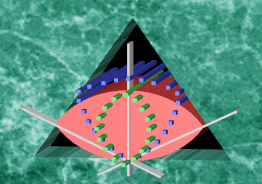 |
Roger Emanuel Kaufman
Professor Emeritus of Engineering and of Anatomy and Cell Biology
Mechanical and Aerospace Engineering
E-Mail: kaufman1@gwu.edu |
.
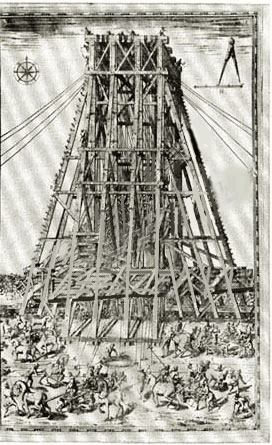 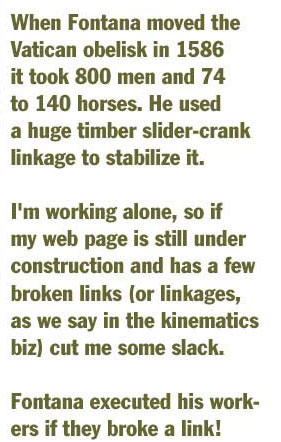
*Little known historical fact: In 1586 the inventor Rogerius Kaufmanicus took the above motion picture using his recent creation, the Camerius Digitalis Animatus. Unfortunately Rogerius failed to patent his invention at the time, and died penilus (as they said in those days) so the above rare film of Fontana moving the obelisk is all that remains as evidence of his achievement.
Education

Tufts University (College of Engineering)
Department of Mechanical Engineering (1958-1962)
B.S., 1962
Yale University (School of Drama)
Department of Theatre Engineering (1962-1965)
M.F.A., 1965
Yale University (Graduate School)
Department of Engineering and Applied Science (1965-1966)
Rensselaer Polytechnic Institute (School of Engineering)
Division of Machines and Structures (1966-1968)
M.E., 1968
Rensselaer Polytechnic Institute (School of Engineering)
Division of Machines and Structures (1967-1969)
Ph.D., 1969
P.E. License #7477 (District of Columbia)
Speciality Areas and Research Projects

- Created new family of electro-mechanical tissue distraction surgical instruments for minimally invasive treatment of scoliosis, pectus excavatum, and other diseases. (with Children's Hospital National Medical Center)
- Researched innovative surgical instruments for scoliosis and other diseases.
- My simulations and designs for innovative surgical instruments for scoliosis and other diseases.
- Created and ran GW Office of Community Service volunteer project "Bridging the Gap: Creative Technological Aids for Children with Neuromuscular Handicaps" with Children's Hospital National Medical Center
- Advised students, designed, and built portions of the GW Obama Presidential Float
- Biomedical engineering of surgical instruments
- Designed haptic simulators for virtual reality training of doctors
- Designed immersive environment simulators for virtual reality training of marines
- Designed assistive living devices and dressing machines
- Biomedical engineering of aids for the handicapped
- Kinematic synthesis and analysis of mechanisms
- Biomechanics
- Computer-aided design
- Historical photos of early work on interactive system for NCI on radiation therapy treatment planning
- Historical photos of early work on interactive system for kinematic synthesis and analysis of mechanisms
- Mini/micro computer applications
- Former member, The GW Institute for Computer Graphics
- Former Faculty Advisor,, The GWU Mini Baja Project
- Former member of Steering Committee, The GW Institute for Biomedical Engineering (GWIBE)
- Former chair, Laboratories and Infrastructure Committee, The GW Institute for Biomedical Engineering (GWIBE)
- Former member of Advisory Group, The Laboratory for Advanced Computer Applications in Medicine
- Former Coordinator, SEAS Special Projects Laboratory
- Former Faculty Coordinator, SEAS Machine Shop
- Taught mechanical design classes at GW and at MIT and developed numerous innovative design competitions
Books

- A FORTRAN Coloring Book, Cambridge, Massachusetts and London England, The MIT Press, 1978. 285 pp., paperback ISBN 0 262 61026 4
- FORTRAN KEPESKONYV, (Hungarian Translation of A FORTRAN Coloring Book), Translated by Dr. Kemeny Tamasne, Muszaki Konyvkiado, Budapest, 1983
(The FORTRAN Coloring Book received an unusual amount of publicity for a technical computer book. It was reviewed under 'New and Noteworthy Paperbacks' in the New York Times Book Review Section for April 30, 1978. The German news magazine, Der Spiegel, carried a picture from the book and a review in its 'Prisma' section for July 3, 1978. The book appeared on a C.B.S. television news report from the Moscow International Book Fair, and was the subject of a syndicated New York Times article which appeared in newspapers around the country. The book also was reviewed in several foreign publications, such as London's New Scientist for September 21, 1978.
Wikipedia back in 2007 used the FORTRAN Coloring Book as an example of "Educational Uses" of coloring books and the book continues to be cited and quoted in hundreds of contexts to this day. For instance, as part of Library Week 2010 the Franklin Pierce Law Center Library set up a chalk board asking patrons to name a favorite book. By Friday both sides of the board were covered in favorite books. Sixty-one books were listed including a Fortran Coloring Book in company with such classics as Anna Karina, Crime and Punishment, Leaves of Grass, and Good Night Moon. A search on "What single book is the best introduction to your field (or specialization within your field) for laypeople?" brought up a Fortran Coloring Book
in company with
Bertrand Russel's The Problem's of Philosophy
and other such lesser-regarded works.
- Introduction to Burmester Theory, unpublished text used in courses at G.W.U., M.I.T., University of Wisconsin, and in special NSF College Teachers Summer Program at Oklahoma State University.
Films

(These five 16mm. KINSYN films are now part of the permanent collection of The Library of Congress and are stored at the National Audio-Visual Conservation Center's Packard Campus in Culpepper Virginia.)
- "KINSYN III" 16 mm. motion picture, sound, 2,200 ft., one hour duration, originally presented at the 14th ASME Mechanisms Conference, Montreal, Canada, September, 1976.
- "KAUFMAN'S KINSYN KINEMATIC KINETOGRAPHY KAPER" 16 mm. motion picture, sound, 425 ft., 11 minutes duration, originally presented at the 13th Design Automation Conference, San Francisco, June 1976 and at the 14th ASME Mechanisms Conference, Montreal, Canada, September, 1976.
- "KAUFMAN'S KINSYN KINEMATIC KINETOGRAPHIC KARTOON", 16 mm. motion picture, sound, 225 ft., 6 minutes duration, originally presented at the 14th ASME Mechanisms Conference, Montreal, Canada, September, 1976.
(These three films have been requested for showing by numerous companies, universities, and government laboratories. Among these have been Mattel, General Electric, E.I.duPont deNemours, General Motors, Stanford, Carnegie Mellon, University of Wisconsin, and others. Several companies and universities have acquired copies of these films. Among these have been American Can Co., Digital Equipment Company, MCAUTO, General Dynamics, the U.S. Naval Academy, and others. MCAUTO and Boeing Computer Services based the development of their mechanism synthesis software packages on material shown in these films.)
-
"KINSYN - An Interactive System for the Kinematic Synthesis of Mechanisms"16 mm. motion picture, sound, 28 minutes duration, originally presented at the Third World Congress on Theory of Machines and Mechanisms, September 13-20, 1971, Dubrovnik, Yugoslavia; also presented by invitation at "On-Line 72: International Symposium and Exhibition of On-Line Interactive Computing", September 4-7, 1972, Uxbridge, Middlesex, England.
(This film has been shown at several other conferences in this country and abroad; in addition, it was a part of M.I.T.'s Inaugural Events Program on the occasion of the inauguration of President Wiesner. It has frequently been requested by professors in computer science, kinematics, and engineering design at a number of universities; and has been shown at numerous industrial seminars at companies such as General Motors, Western Electric and Procter and Gamble, and at government agencies such as NASA.)
- "Teabag Machine and Front End Loader" 16 mm. motion picture, silent, 250 ft.,6 minutes duration, originally presented at the 14th ASME Mechanisms Conference, Montreal, Canada, September, 1976.
- "Toys for the Handicapped" 14 minute 35 mm sound color motion picture produced by United Cerebral Palsy National Association, showing devices designed and built by students working under the direction of R.E.Kaufman
Videotapes

- "Creative Technological Aids" 4:45 minutes videotape, American Broadcasting Co., 1976, made for 1976 Cerebral Palsy National Telethon, showing devices designed and built by students working under the direction of R.E.Kaufman.
- "An Anthropomorphic Eight-Bar Spine Simulator", shown at the Keynote Session of the 8th Design Automation Conference, September 12, 1982.
- "KINSYN7"15 minute videotape shown at numerous companies and by invitation at conferences such as the National Design Engineering Shows and Conferences, McCormick Place, Chicago, and the Eastern and Western Design Engineering Shows of the ASME.
- "PantsPutterOnner", showing a dressing machine designed and built by Roger E. Kaufman for a former G.W.U. doctoral student born without arms.
- "ShirtPutterOnner", showing a dressing machine designed and built by Roger E. Kaufman for a former G.W.U. doctoral student born without arms.
- "Overhead Virtual Reality Harness Systems for Full-Body In-Place Virtual Interaction", 4 Min. Video, IEEE Virtual Reality 2007
- "Kneeling and Go-Prone Inverted and Overhead Harness Systems for Full-Body In Place Virtual Interaction", 6 Min. Video, IEEE Symposium on 3D User Interfaces, 3DUI 2007
- "Kaufman Standing Assist Device", 2.23 Min. Video, showing a prototype assist device for persons with ailments such as knee problems, back problems, or weakness due to aging.
- A bunch more of my random videos, films, research projects, Mini Baja competitions, student design projects, historical CAD videos and other weird stuff...
Patents

Published Patent Applications
Other Publications

- "A Family of New Ergonomic Harness Mechanisms for Full-Body Natural Constrained Motions in Virtual Environments", IEEE Symposium on 3D User Interfaces, 3DUI 2007
- "Harness Mechanisms for Full-Body Motions in Virtual Environments", Poster, IEEE Virtual Reality 2007
- Demonstrated the “Kaufman Pedestal Virtual Reality Harness” at the 11th International Conference on Human-Computer Interaction, Caesar’s Palace Hotel, July 22-27, 2005, Las Vegas, Nevada. (By invitation.)
- Virtual Reality, video and invited talk at the TTI/Vanguard’s “NextGens Technologies” 2005 conference in Washington D.C.
- "Virtual Technologies and Environments: New Centering Harness Designs”, Naval Training Science and Technology Meetings, Office of Naval Research, Washington DC. (Several years)
- "Training Environment for Inferior Vena Cava Filter Placement", Proceedings of Medicine Meets Virtual Reality 6, San Diego, CA, Jan 28-31, 1998 and published in Studies in Health Technology and Informatics Volume 50, pp. 291-297. (with J. Hahn, Ph.D., A. Winick, M.D., T. Carleton, Y. Park, R. Lindeman, K.M. Oh, Ph.D., N. Al-Ghreimil, R. Walsh, Ph.D., M. Loew, Ph.D., J. Gerber, and S. Sankar.
- "Virtual Reality Surgical Simulation for Lower Urinary Tract Endoscopy and Procedures", Michael J. Manyak, Kristin Santangelo, James Hahn, Roger Kaufman, Thurston Carleton, Xing Cheng Hua, Raymond J. Walsh, Journal of Endourology. Apr 2002, Vol. 16, No. 3: 185-190 and in Journal of Bladder Disease, Part A: Research Concepts and Clinical Applications, pp 841-852, 2003.
- "Making Surgical Simulations a Reality: Technical and Practical Issues for Applications in Medicine", James Hahn,Ge Jin, Dongho Kim, Roger Kaufman, Michael Manyak, John Rewcastle, Raymond Walsh.
- "The Laboratory for Advanced Computer Applications in Medicine", Raymond J. Walsh, Michael Manyak, Roger Kaufman, Murray Loew, and Jean Johnson Abstract to Experimental Biology Annual Meeting, April 22-26, 2002 , New Orleans , LA.
- "The Laboratory for Advanced Computer Applications in Medicine (LACAM)", Raymond Walsh, James Hahn, Michael Manyak, Roger Kaufman, Murray Loew, FASEB JOURNAL, Mar 20, 2002, Vol. 16, No. 4, pA382.
- Raymond J. Walsh, Michael Manyak, Roger Kaufman, Murray Loew, and Jean Johnson, " The Laboratory for Advanced Computer Applications in Medicine", Abstract to Experimental Biology Annual Meeting, April 22-26, 2002 , New Orleans , LA.
- "Bridging the Gap: A Volunteer Project to Develop Creative Technological Aids for Children with Neuromuscular Handicaps", R. Q. Glickman. T.A. Howard, R. Kaufman, 10th Annual Children's National Medical Center Research Day, April 22-23, 2010, Companion Booklet P.162.
- "KINSYN III: A New Human-Engineered System for Interactive Computer-Aided Design of Planar Linkages", ASME Paper No. 76-DET-48, Journal of Engineering for Industry, Trans ASME, Volume 99 Series B No. 2, May, 1977, pp. 440-448 (with A. J. Rubel).
- "Isodose Synthesis in Homogeneous Phantoms Using a Velocity-Constrained Bivariate Collimator", Proceedings of the Fourth New England Bioengineering Conference, Yale University, 1976. (Abstract published in Biotelemetry, International Journal on Biotelemetry and Patient Monitoring, Vol. 2, No. 1-2, 1975) (with F. E. Munschauer III and R. B. Washburn, Jr.)
- "Magic Mice: A Linkage-Based Toy for Handicapped Children", Proceedings, Fourth Applied Mechanisms Conference, Chicago, Nov. 1975 (with D. Idec Chambers).
- "KINSYN: An Integrated Man-Machine System for the Design of Mechanisms", Proceedings of the Fourth Oklahoma State University Applied Mechanisms Conference, Chicago, 1975 (with A. J Rubel).
- "KINSYN: A Minicomputer-Based Interactive Mechanisms Design System", Proceedings, 13th Design Automation Conference, San Francisco, June, 1976 (with A. J. Rubel).
- "Kinematic and Dynamic Design of Mechanisms", presented at the International Symposium on Structural Mechanics Software, College Park, Maryland, June 14, 1974 (invited paper) and published in Shock and Vibration Computer Programs - Reviews and Summaries, SVM-10, Shock and Vibration Information Center, U.S. Dept. of Defense, pp. 337-346, 1975.
- "Bridging the Humanist-Mechanist Gap: Creative Technological Aids for the Disabled", Proceedings, 1976 Conference on Systems and Devices for the Disabled, Boston, June, 1976 (with G. Dalrymple, M. Driscoll, and N. Kamil).
- A General Method for the Kinematic Synthesis and Force-Balancing of Spatial Mechanisms, Doctoral Dissertation, Rensselaer Polytechnic Institute, Troy, New York; University Microfilm, No. 70-11, 322, Ann Arbor, Michigan, 263 pp., (1969).
- "KINSYN PHASE II: A Human Engineered Computer System for Kinematic Design and a New Least-Squares Synthesis Operator", Invited paper, Journal of Mechanism and Machine Theory, Pergamon Press, 1973, Vol. 8, pp.469-478.
- "KINSYN - An Interactive Kinematic Design System", presented at the Third World Congress on Theory of Machines and Mechanisms, September 13-20, 1971, Dubrovnik, Yugoslavia and published in the Transactions of the Congress.
- "Application of an Interactive Computer Graphics System to the Kinematic Design of a Polycentric Knee Joint", invited paper presented at On-Line 72, International Conference on On-Line Interactive Computing, Sept. 3-7, 1972, Brunel Univ., London, England and published in the Transactions of that conference; also presented at the ACM Symposium on Computer Graphics in Medicine, March 9, 1972 held at Point Park College, Pittsburgh, Pennsylvania,and published in the Proceedings of that conference; also invited for publication in Computers in Biology and Medicine.
- "Complete Force Balancing of Spatial Linkages", presented at the Sixth U.S. Congress of Applied Mechanics, Harvard University, June 16, 1970; ASME Paper Number 70-DE-A, Journal of Engineering for Industry, Trans ASME, Volume 93 Series B, No. 2, May, 1971, pp. 620-626, (with G. N. Sandor).
- "KINSYN III: For Design of Planar Linkages", MECHANICAL ENGINEERING, Vol. 99, No. 2, February, 1977 (with A. J. Rubel).
- "Operators for the Kinematic Synthesis of Mechanisms by Stretch-Rotation Techniques", presented at the 11th ASME Mechanisms Conference, November 3, 1970, Columbus, Ohio; ASME Paper Number 70-Mech-79 (with G.N. Sandor).
- "Interactive Linkage Synthesis on a Small Computer", presented at the 1971 ACM National Conference, Aug.3-5, 1971, Chicago, Illinois and published in the Proceedings of the conference; also an invited paper presented at The Second Oklahoma State University Applied Mechanism Conference, October 4-8, 1971, Stillwater, Oklahoma and published in the Transactions of that conference (with W. G. Maurer).
- "Synthesis of the Watt-1 Six-Bar Linkage for Five Position Higher Coupler Motion Correlated with Input Rotations", presented at The Second Oklahoma State University Applied Mechanisms Conference, Oct.4-8, 1971, Stillwater, Oklahoma and published in the Transactions of the conference.
- "The Bicycloidal Crank - A New Four- Link Mechanism", ASME Paper No. 68- Mech-14, presented at the 10th ASME Mechanisms Conference, Atlanta, Georgia, Oct. 10, l968; published in Journal of Engineering for Industry, Transactions of the ASME, Feb., l969, Vol. 91, Series B., No. 1, pp.91-96 (with G.N. Sandor).
- "Kinematic Synthesis of Geared Linkages", Paper No. 1, Applied Mechanisms Workshop and Conference, July 28-Aug. 1, l969, Stillwater,Oklahoma, winner of First Honorable Mention at that Conference and published in the Transactions of that conference; presented by invitation at Academie de la Republique Socialist de Roumanie, Conference Nationale de Mecanique Appliquee, Bucarest, Roumania, and published in the Proceedings of that Conference; presented at an invited lecture at Miskolc Technological University, Hungary, 1969; and published by invitation in The Journal of Mechanisms, Pergamon Press, Volume 5, Number 1, Spring 1970, pp. 59-87 (with G.N. Sandor).
- "Mechanism Design by Computer," Invited Article, Machine Design Magazine, Penton Publishing Co., October 26, 1978, pp. 94-100.
- "Optimal Synthesis of an Eight-Bar Crash Test Device", Proceedings, 1982 Summer Computer Simulation Conference, July 19-21, 1982, pp. 289-292 (with J. Pena and R. Eppinger).
- "Three-Position Precessing Mechanism Synthesis", Cengiz Oren and Roger Kaufman, Proceedings, 7th Applied Mechanisms Conference, Kansas City, MO. and published in Mechanism and Machine Theory, Vol. 19, No. 1, pp 139-148, 1984.
- "Design and Construction of an Analog Punch Card Lighting Control System",Master's Thesis, Yale University School of Drama, 1965 (with P. Dennis Carnine).
- The Bicycloidal Crank - A New Four-Link Mechanism, Master's Thesis, Rensselaer Polytechnic Institute, 1968.
- "Electromechanical Aids for Handicapped Children", presented at the 28th Annual Conference on Engineering in Medicine and Biology, New Orleans, Louisiana, Sept. 20-24, 1975; abstract published in the Proceedings of that conference.
- "Singular Solutions in Burmester Theory", presented at the 12th ASME Mechanisms Conference, San Francisco, California, October 9-11, 1972. ASME Paper No. 72-Mech-23.
- Introduction to Spatial Kinematics, 2002-2008, On-line PDF notes on spatial mechanisms. (45 Pages.)
- Hartenberg-Denavit Method, 2002, 45 Page on-line PDF notes based on the classic text by R.S. HartenBerg and J. Denavit Kinematic Synthesis of Linkages, McGraw-Hill, New York, NY, 1964.
- Three-Dimensional Kinematics, 2002-2008, On-line PDF notes based in part on lectures by Allen S. Hall, Jr., George N. Sandor, Richard Hartenberg, Ferdinand
Freudenstein, Bernard Roth, C.H.
Suh, An Tzu Yang, at the Summer Conference
on Kinematics Theory and Practice, Massachusetts Institute
of Technology, July 11-22, 1966 and on earlier work by Jacques Denavit, Rudolf Beyer,, Joseph Beggs, and others too numerous to
mention. (With random embellishments of my own!)
(181 Pages.)
- Most of my publications can be found and downloaded from Academia by clicking here.
Articles about Professor Kaufman

- The 50th Anniversary Tribute Issue to Engineering of Machine Design Magazine , September 20, 1979 carried an article "A Troubled World Looks to Technology." That article had a photo and description of the KINSYN I computer system being used to design an artificial limb.
- That same KINSYN I photograph also appears in Francis E. Wylie's book M.I.T. in Perspective, the official history of The Massachusetts Institute of Technology from 1861 to 1976. (Little Brown, Co.)
- The Editorial by J. Michael McCarthy in The Journal of Mechanisms and Robotics, February 2011, Vol. 3 entitled "Kinematics, Polynomials, and Computers--A Brief History" includes a photo and discussion of KINSYN.
- The paper "Lessons Learned from Kinematics Research Applied to Medical Device Design" by Arthur Erdman in The Journal of Biomedical Engineering, February 2018, Vol. 140 includes several photos and a discussion of the pioneering role of KINSYN and its role in the first interactive patient specific design of a medical device.
- The Detroit Free Press had an article on uses of humor in serious areas, such as psychiatry. Professor Kaufman was interviewed for the article and The FORTRAN Coloring Book was used as an example.
- Machine Design Magazine for October 20, 1977 had a feature news article entitled "Mechanical Design: Let the Computer Do It". The KINSYN III computer system was the main topic of this article.
- Machine Design Magazine for October 7, 1982 had a feature article entitled "Software for Mechanical Design." There was a sidebar in that article entitled "Mechanism Design on a Microcomputer" which was a discussion of Micro KINSYN along with five photos of the system. Also there was extensive mention of KINTECH and of the KINSYN7 system as well.
- Machine Design Magazine for March 24, 1983 had a feature article entitled "Designing Mechanisms on a Personal Computer." This article was specifically about Micro KINSYN and a second program marketed by Terak, Corp. which was originally patterned after KINSYN.
- Machine Design Magazine for August 20, 1987 had a feature article by the staff editor entitled "Modeling Dynamic Mechanical Systems." This article starts with "Mechanism design using desktop computers was pioneered by Roger Kaufman of KINTECH who first offered his KINSYN package on souped-up Apple //e computers..."
- A number of other articles have also referred to the KINSYN system as having been the first such computer system for interactive mechanism design.
- The "History of Computer-Aided Mechanism Design" section of Mechanism Design by Erdman and Sandor (Prentice Hall, 1997) says "computer graphics applied to mechanism design received its christening in the early 19701s by Kaufman. KINSYN1 was a custom-built program at M.I.T. and should be recognized as the major milestone in kinematic design"
- The most recent edition of Theory of Machines and Mechanisms by Uicker, Pennock, and Shigley (Oxford University Press, 2011) says "The earliest such program was KINSYN (KINematic SYNthesis)..." and goes on to devote a half page to a classic photo of a device I designed during filming of the KINSYN III movie over three decades ago.
- My virtual reality simulator research was the topic of a Faculty Focus sidebar entitled “Harnessing Success”, Jamie L. Freedman, GW Magazine, p. 7, Fall 2005
- It was also the topic of several paragraphs in “My Virtual War: A disturbing stroll through a simulated battlefield”, Mark Alpert, Scientific American, pp 94-95, February 2006
- My Marine virtual reality simulator harness research was also the topic of several paragraphs in “Navy Researchers Target, Virtually”, Robert K. Ackerman, Signal, AFCEA International Journal, July 2006
- Numerous publications by and about the award winning Aeron® and Embody® chairs by Herman Miller Company state that "Research conducted by designer Bill Stumpf with Roger Kaufman at George Washington University identified the relationship of the body’s major pivot points as it moves between forward and deeply reclined sitting. This work resulted in the Kinemat® tilt of the Aeron® chair in 1994." For instance, see the papers Promoting Healthy Movement and Natural Alignment: THE RESEARCH AND DESIGN BEHIND THE EMBODY® TILT, or The Kinematics of Sitting: Ergonomic criteria for the design of the Aeron® chair by Bill Stumpf, Don Chadwick, and Bill Dowell.
- The article "Engineering design education and rehabilitation engineering" by the late Robert W. Mann, ScD, Whitaker Professor Emeritus, Biomedical Engineering, Department of Mechanical Engineering, Massachusetts Institute of Technology, Cambridge, MA, gives an excellent discussion of the Creative Technological Aids project we had with Kennedy Hospital for Children. Here is an excerpt from that article.
Awards

- Appointed "Professor Emeritus", The George Washington University, Apri 26, 2010.
- Selected to be the faculty greeter for First Lady Michelle Obama, The George Washington University 2010 Commencement on the National Mall, May 16, 2010.
- Recipient, "2010 Distinguished TeacherAward", The George Washington University School of Engineering and Applied Science, April, 2010.
- Recipient, "President's Council on Service and Civic Participation Gold Level Volunteer Service Award", President's Council on Service and Civic Participation in conjunction with Corporation for National & Community Service, April, 2010.
- Recipient, "2005 Career Achievement Award", Tufts University Mechanical Engineering Department, May 7, 2005.
Listed in Who's Who in America, 2007.
- Listed in “American Men of Science, Eleventh Edition”.
- Listed in “Who’s who in Engineering Education”.
- Recipient, Faculty Advisor Award in the 1998 BFGoodrich National Collegiate Inventor's Competition for advising Martin B. Montague's project "Virtual Roll Suspension/Drive" , one of the three undergraduate winners in the nation. The award ceremony was part of the Induction Weekend for the National Inventors Hall of Fame, Akron, Ohio.
- Recipient, "A Special Recognition Award for Significant Efforts in CAD, KINSYN I, KINSYN II, KINSYN III, and Micro KINSYN" at the 10th Applied Mechanisms Conference, New Orleans, LA, December, 1987.
- Recipient at the same conference of "A Special Recognition Award" for having participated in all ten of the Applied Mechanisms Conferences held during the previous twenty years either as an author, panelist, or session chairman.
- Recipient, American Society of Mechanical Engineers' 1976 Mechanisms Committee Award for "Outstanding Contributions to the Field of Mechanism Design or Theory."
- Recipient, Best Paper Award at the 14th ASME Mechanisms Conference, September, 1976, Montreal, Canada (out of 106 papers at the conference).
- Named "duPont Assistant Professor of Mechanical Engineering" at M.I.T. for year July 1, 1970-July 1, 1971. (This was the only named assistant professorship at M.I.T. at the time.)
- Nominated for the GW 2008 Spark A Life Award granted to one faculty or staff member who has significantly impacted the holistic development of a student or registered student organization, thus causing a "spark" of inspiration.
- Chairman, American Society of Mechanical Engineers Mechanisms Committee (1981-1983)
- Honorary Director, Creative Technological Aids, Inc.
- Charter Member, U.S. Institute for Theater Technology, New York Chapter.
- Member, Society of the Sigma Xi
- Honorary Member, Pi Tau Sigma
- National Science Foundation Research Assistantship (Rensselaer Polytechnic Institute) (1966-1969)
- Rockefeller Foundation Fellowship in Electromechanical Techniques in the Theatre (Yale University) (1964-1965)
- Class of 1898 Goddard English Prize (Tufts University) (1958-1959)
- Tufts University Honorary Drama Society
Other

President and founder of KINTECH, Inc. 1982-1989
(KINTECH developed and marketed KINSYN7 and MicroKINSYN. These were specialized computer-aided mechanism design systems. Among the users of KINTECH's products were McDonnel Douglas Company, General Motors Fanuc, AMP, Inc., Proctor and Gamble, General Dynamics, Polaroid, Xerox, and others. McAuto, Boeing Computer Services, and others have since developed kinematics software packages based on the KINSYN7 system.)
As a consultant to Herman Miller, Inc., I designed and synthesized the reclining chair mechanisms which are the heart of U.S. Patent 4,718,716 assigned to Herman Miller.
As a consultant to Bill Stumpf & Associates, I also was the originator of the "Kinemat Tilt®" mechanism and principle which became both the kinematic and visual heart of Herman Miller's award-winning Aeron® chair and which is the basis for the "Embody Tilt® in the more recent Embody® chair. The Aeron chair won ID Magazine's Best in Furniture in its 1995 "Annual Design Review." It set a new benchmark in both ergonomics and aesthetics and quickly found a place in the design collections of major museums. It was named the "Design of the Decade" and is in the permanent collection of the Museum of Modern Art. The Embody chair was named the "Best of 2008" by Wired Magazine. The Aeron is covered by U.S. Patent D346,279 as well as by the following foreign patents: German M9209024.9; Great Britain 2027194; Spain 0129035; France 9207613; and Taiwan 38287.
Another major invention I originated in 1961 was the Home Trash Compactor. My 1961 design was shown to a jury of engineers from industry as part of an undergraduate class I took at Tufts University. Ten years later Whirlpool and Kenmore came out with a commercial version that was essentially the same as my original design. That product became the best selling home appliance of the year in 1970, the year it was introduced.
Elements from my KINSYN computer software have been copied by several companies, both here and abroad. For example, KINSYN formed the basis for McAuto's (McDonnel Douglas Automation's) mechanism synthesis package.
As a "consulting teacher" I have freely given away many ideas to my students and others. Among the ideas I originated which have become the source for major patented products was the kinematic principle behind the "Remote Center Compliance" robot wrist. I gave this idea to a pair of my MIT graduate students who came to me for help while they were working for Draper Laboratories. Draper and others now have patents on the RCC. It has become a basic robotic component. A number of companies including IBM now manufacture these devices.
My life in the theater and how I Accidentally Ended Up a Professor of Engineering...
Lately I have been working on a simple perpetual motion machine that I expect will make my fortune. If no prior art shows up I plan to retire on the patent licensing fees!
.
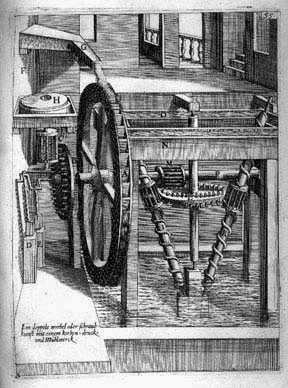
.
* One of Kaufman's Corrupted Historical Documents based on Theatrum MachinarumNovum, Exhibens Opera Molaria Et Aquatica Constructum Industria, George Andrea Bockleri, MDCLXII
|
|




